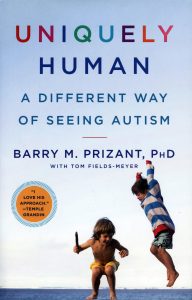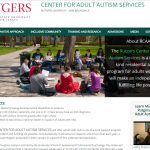 For many parents, a diagnosis of autism answers one question but does not explain why their son or daughter has such difficulty expressing feelings, needs, and desires or why their social behavior differs so much from that of their peers. Confronted by this mystery, these parents are understandably anxious. What Barry Prizant seeks to do is to “turn self-doubt in to confidence and comfort, and to help them see as possible what they thought was impossible.” The starting point is to adopt a fundamentally different way of seeing and understanding autism. Most educators speak of “autistic behaviors,” undesirable traits that should be eliminated. That is the classic medical model of autism, a condition or mental illness, or even a psychiatric abnormality. That, says Prizant, needs to change. “Autistic behaviors” are human behaviors.” Furthermore, “Autism isn’t an illness. It’s a different way of being human…. To help [children with autism], we don’t need to change them or fix them. We need to work to understand them, and then change what we do.” In other words, Prizant adopts the perspective of neurodiversity, that conditions such as autism are part of our genetic make-up, a different way of thinking and being, “uniquely human.”
For many parents, a diagnosis of autism answers one question but does not explain why their son or daughter has such difficulty expressing feelings, needs, and desires or why their social behavior differs so much from that of their peers. Confronted by this mystery, these parents are understandably anxious. What Barry Prizant seeks to do is to “turn self-doubt in to confidence and comfort, and to help them see as possible what they thought was impossible.” The starting point is to adopt a fundamentally different way of seeing and understanding autism. Most educators speak of “autistic behaviors,” undesirable traits that should be eliminated. That is the classic medical model of autism, a condition or mental illness, or even a psychiatric abnormality. That, says Prizant, needs to change. “Autistic behaviors” are human behaviors.” Furthermore, “Autism isn’t an illness. It’s a different way of being human…. To help [children with autism], we don’t need to change them or fix them. We need to work to understand them, and then change what we do.” In other words, Prizant adopts the perspective of neurodiversity, that conditions such as autism are part of our genetic make-up, a different way of thinking and being, “uniquely human.”
Advocating for Autism Acceptance at the U.N.
Dr. Prizant spoke of his “different way of seeing autism” at the U.N. conference. Autism should not be seen as a checklist of deficits (e.g., as having challenges in socializing and communicating, engaging in repetitive patterns, showing autistic behaviors such as stimming); rather, autistic people have their own way of seeing the world and engaging in society. The “autistic behaviors” are strategies people on the autism spectrum use to cope with a world that to them is often chaotic and overwhelming. And those interests or fixations? Dr. Prizant refers to them as “enthusiasms,“ just one of the many unique gifts autistic people have to offer.
 This year’s Autism Awareness Day, the United Nations hosted an all-day conference, “Toward Autonomy and Self-Determination,” which we covered in one of our earlier blog pieces. The event was recorded; Dr. Prizant’s speech begins at 2:53.
This year’s Autism Awareness Day, the United Nations hosted an all-day conference, “Toward Autonomy and Self-Determination,” which we covered in one of our earlier blog pieces. The event was recorded; Dr. Prizant’s speech begins at 2:53.
- Let’s begin to depathologize autistic behavior (e.g., stimming, echolalia). Even in recent years, there were studies on how to stop self-stimulation behavior, even with shock and punishment. Now, people on the spectrum. Now people on the spectrum have reclaimed self-stims, “meaning that we teach people that it’s the way we regulate, the way we deal with stress.”
- “Autism, in many cases is not a tragedy,” though it may become a tragedy when it is accompanied by poverty, lack of appropriate support.
- Autism self-determination begins in early childhood. When we teach children from very early on to make decisions, to protest, to refuse, to have some say in their lives. We cannot begin to think about self-determination in the adolescent or adult years, as it is too often done right now.
And then, finally, let’s look at ourselves. “The best way to help people with autism is to understand them and then change what we do. There is still too much of a focus on we need to change people with autism. “If we understand autism as a shared human experience, not just as something in a person that needs to be fixed, that opens up all kinds of possibilities for us to be a more compassionate society, for us to be more helpful towards each other, and for us to understand that continuum of humanity in all of us.”
Understanding Emotions
How do we work to understand children with autism, to help them? And how do we change what we do? Prizant explores these questions in the first part of Uniquely Human, “Understanding Autism.” He proposes six steps:
Ask “Why?” The first step is to go beyond answering why a child exhibits certain behaviors or patterns of speech with “because he has autism,” which leads to answering a question of why he has autism with “because he shows certain behaviors.” Asking “Why?” entails going deeper, inquiring why a child does what she does. The answer, says Prizant, is that the person is feeling emotional dysregulation. In other words, people with autism experience discomfort, confusion, and anxiety more intensely than do most people, along with considerable difficulty coping with these emotions. Many people with autism do what they do because it helps them, these behaviors are coping strategies or mechanisms. What the autistic child wants – and needs – is information (even if the answer is readily apparent) to reduce the anxiety of uncertainty.
Listen. Asking “Why?” is about empathy, and so is listening. What may sound absurd or silly is, in fact, not. The autistic child is telling a story. For example, repeating a phrase, known as echolalia, is not nonsense talk, just another example of autistic behavior. And it’s not “autistic behavior,” a pathology that presents an obstacle to the child fitting in socially. Echolalia is, in Prizant’s words, an alternative way of communicating, using language for the same reasons everyone else does. In fact, echolalia serves as a starting point, a learning strategy to acquiring language.
Accept enthusiasms. Enthusiasms is Prizant’s term for what many people term “obsessions.” Rather than being another “autistic behavior” that needs to be eliminated for the child to fit in socially, provide the child with autism with a motivational tool for learning. Teachers and parents should use the autistic child’s enthusiasms as a bridge to learning other skills. Hobbies fill a need in all of us: “An experience feeds a basic neurological need to be engaged, to appreciate beauty, and to experience positive emotion.” These interests can lead one to find a uniquely fulfilling path in one’s work and life, as we are reminded by Sir Ken Robinson in his book, The Element. In this chapter, Prizant gives several excellent examples.
Understand trust, fear, and control. According to Prizant, autism is best understood as a disability of trust: trust in the body, the world, and others.
- Trust in the body. Children with autism have to cope with involuntary motor movements and, in the brain, thoughts.
- Trust in the world. From the perspective of a child with autism, any change in routine is a violation of his trust in the world around him.
- Trust in people. Because many people with autism find it difficult to “read” people, to predict their behavior, unexpected actions (even those that are entirely unintentional) pose a threat. Autistic people go through life in a state of a heightened, hypervigilant alert. Other people with autism have the opposite challenge: they react more slowly than others, internalizing their anxiety rather than directing it outward through behavior.
When one’s trust is challenged, the natural reaction is often to seek to exert control. That does not mean that the autistic person is controlling or that such behavior needs to be extinguished. What parents and teachers need to do is to build trust by acknowledging attempts to communicate, giving the person with autism choices in planning events, accepting the individual’s dysregulated emotional state, being dependable and clear, and celebrating successes, even small ones.
Recognizing emotional memory. Emotional memories are those that are associated with a happy or sad, hopeful or frightening event. Given that many people with autism have exceptional memory and, as stated earlier, often live in a state of heightened alert (similar to PTSD), these emotional memories are particularly strong in people with autism. “A seemingly small association,” says Prizant, “can trigger what seems to be a disproportionately dramatic reaction.” Anyone working with an autistic child must try to avoid these emotional triggers or offer something that can provide comfort, such as noise-cancelling headphones.
Helping with social understanding. People with autism having difficulty with social understanding react in one of two ways: They are oblivious to their blunders, or they are extremely anxious about what they do not understand. Social skills training can help, but because the rules of social understanding come with so many exceptions, such teaching does not always work. At the very least, social rules need to be taught very clearly and with directness – and explaining the meaning of phrases exactly and literally. In addition, labeling pictures of people expressing certain emotions is ineffective; describing emotion in words is one of the most abstract tasks anyone can undertake. It is better to introduce the appropriate label at the very moment that person is experiencing that particular emotion. Moreover, says Prizant, the effort of autistic individuals to succeed in this area often causes them great stress.
Living with Autism
Teaching and caring for a child with autism takes a special person, someone who has “got it.” These people know how to relax with the autistic child, to relate to him. What does it take? As Prizant explained, these people have empathy and sensitivity. They ask “Why?” – why an autistic child is acting at this time and not another. People who have “got it” share control with the autistic child. They have a sense of humor. They instill trust. They are flexible. What these people who have “got it” do not do is compile a list of deficits. Rather than paying attention to a plan, they pay attention to the child, overlooking small setbacks in favor of seeing the overall trajectory of improvements in the way the autistic child is able to self-regulate. For teachers and others working with the child with autism, they respect the parents’ hopes and dreams. After all, says Prizant, parents know their child best. Parents, in turn, should trust their gut, follow their instinct, while finding support groups with other parents of autistic children. In addition, parents should actively advocate for their children but, in so doing, know the difference between being assertive and aggressive, as Prizant aptly discusses.


